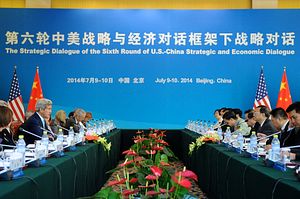Tonight, officials from China and the United States will gather in Washington, D.C. for a dinner that kicks off the seventh round of the “Strategic and Economic Dialogue,” the highest-level annual meeting between the two sides. Talks proper will unfold June 23 and 24. The S&ED will be led by Secretary of State John Kerry and Treasury Secretary Jacob Lew on the U.S. side and by State Councilor Yang Jiechi and Vice Premier Wang Yang on the Chinese side.
So what’s on the agenda for this round of the showcase dialogue platform? Below, four topics to watch that will feature heavily on the agenda, and one thing not to expect.
Economic cooperation and the bilateral investment treaty: This year is a big one for progress on a potential bilateral investment treaty (BIT). Both China and the United States exchanged their “negative lists” — a list sectors that will be exempt from the BIT and thus keep restrictions on foreign investment — at BIT talks last week. The BIT has featured at previous S&EDs – the move to substantial negotiations was announced at the 2013 round of talks, while at the 2014 S&ED negotiators laid out a timetable for finishing talks on the framework and moving to the negative list negotiations.
The negative lists are likely to be the thorniest part of negotiations. China protects a number of sectors – from agriculture to manufacturing to services like insurance – from foreign competition by placing restrictions on investment. For China’s point of view, this is necessary to give Chinese firms a needed leg-up against more developed competition. For U.S. firms, however, it represents an unnecessary barrier to entry. Talk about the negative lists and the BIT in general will be a major focus on the “economic track” of the S&ED.
The environment and climate change: Climate change returned to the agenda of U.S.-China relations in a big way last November, when Presidents Obama and Xi unveiled joint commitments on emissions reductions as part of Obama’s visit to China. This year, the issue will only be more visible, as both China and the United States try to ensure the Paris climate change summit this December does not end in failure. The Paris conference is supposed to end with a new global agreement on emissions reduction; U.S.-China agreement on the main issues at stake (particularly how to share the burden between developed and developing countries) will go a long way toward ensuring that goal is met. There will be a special joint session on climate change on June 23, highlighting the emphasis on this issue. Last year, the climate change agreement provided a welcome bright spot for U.S.-China relations; negotiators will want to replicate that success.
Cyber issues: The United States is scrambling to explain one of the biggest national security breaches in recent memory — a hack into the files of the Office of Personal Management that provided access to the personal information of four million past and present government employees. U.S. officials seem confident the hack originated in China, lending yet more urgency to China-U.S. talks on cybersecurity and other cyber issues. One Obama administration official told the New York Times the OPM hack “was classic espionage, just on a scale we’ve never seen before from a traditional adversary.”
With cyber attacks in the name of espionage likely to continue on both sides – and with calls for Obama to respond forcefully to the OPM hack – it’s even more imperative that Beijing and Washington come to some sort of agreement on what constitutes acceptable behavior in cyberspace. Cyber issues will be under discussion at the Strategic Security Dialogue, a sub-dialogue under the aegis of the main S&ED.
South China Sea: The issue likely to attract the most media attention is of course the South China Sea. Tensions have grown in recent months, with the United States becoming increasingly vocal about its opposition to China’s land reclamation and construction projects. China’s announcement that reclamation would soon be complete was likely designed in part to try and smooth over tensions before the S&ED. It doesn’t seem to have worked, though — while giving journalists a preview of the talks, Daniel Russel, the U.S. assistant secretary of state for East Asian and Pacific affairs, gave China no credit for that move. He did, however, express concern over “the recent announcement out of Beijing that the Chinese Government intends to continue and expand the construction of facilities on the reclaimed outposts that it’s been constructing in the South China Sea.”
China, meanwhile, has continued to defend its construction projects. When asked about the issue, Foreign Ministry spokesperson Hong Lei cited a Chinese saying: “just as distance tests a horse’s strength, time will prove a person’s sincerity.” In other words, China hopes that the United States and other countries will eventually come to believe China’s assertions that its construction is primarily aimed at peaceful, civilian purposes. Right now, the two sides remain deadlocked. The best we can likely hope for is progress on “rules of the road” for unplanned encounters in the air and at sea — including run-ins between U.S. and Chinese vessels and aircraft navigating the South China Sea.
As for what not to expect – don’t look for any marquee announcements from this summit. This S&ED should be viewed not as an end in itself, but as preparation for Xi’s state visit to the United States, which is now less than three months away. According to Russel, the S&ED talks “unquestionably serve to advance the agenda” ahead of that visit. As one example, he said, the 2014 S&ED “was instrumental in teeing up progress on the climate deal that President Obama and President Xi were able to announce in November.” We didn’t see that progress after the 2014 S&ED, however, meaning we shouldn’t be surprised (or disappointed) if there are no major deliverables come June 24.
































